10 Tricks to Reach Out to Leads Faster
Use these tips, tools, and templates to not only reach out to every lead within 5 minutes, but to get responses too.
See how your sales, marketing, and operational performance stacks up against competitors and use our tips to improve in each area.
Every call center wants to understand their performance so they can achieve their goals. But comparing against your own benchmarks can only provide so much insight.
That’s why we surveyed over 120 call centers across 25 key data points to compile this 2024 State of the Home Improvement Call Center report. Use it to get an accurate read on your call center performance and strategize for success in the year to come.
This report is broken into five sections so you can see how you stack up to competitors in sales and marketing performance, operational efficiency, and trend alignment.
Plus, we provide resources along the way to help you in the areas where you find you need improvement. Let’s dig in.
This portion of the survey aimed to surface insights around the strategies home improvement businesses are using to generate inbound leads for their call centers.
The most popular lead generation channels were search and social ads (both used by 85% of respondents) followed by website contact us forms and referrals, used by 78% and 74% of respondents, respectively.
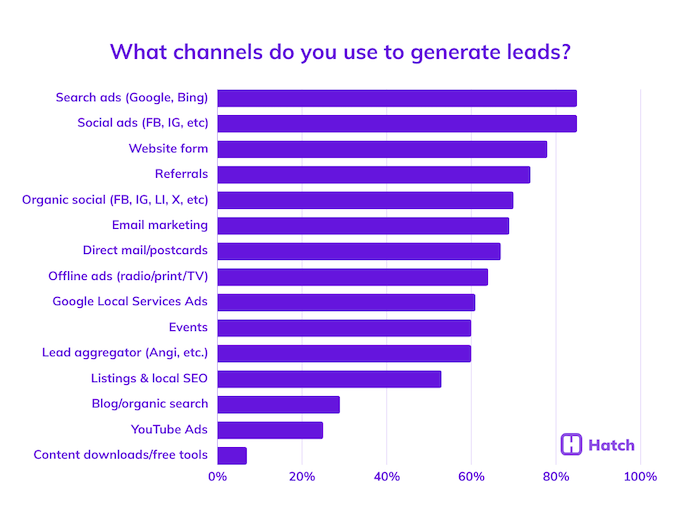
The results show a few different insights:
Online ads had the highest average score of 4.88, followed by lead aggregators at 3.87 and website at 3.65. Just below that were referrals at 3.2 and offline ads at 3.04. Listings had the lowest overall score at 2.36.
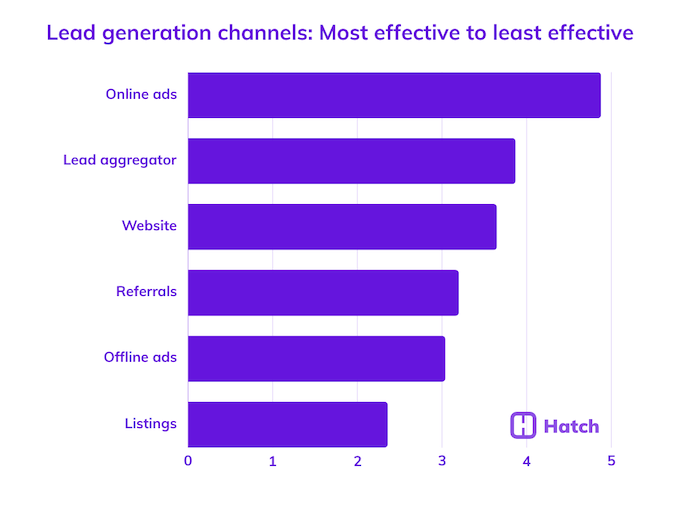
That listings had such a low overall score is unfortunate. 92% of searchers pick businesses on the first page of local search results and 40% of home services consumers who call from search make a purchase. And the key to showing up on local results? Creating and optimizing your listings. Plus, listings improve brand awareness which in turn improves conversion on your online ads and website. Use our best business listing sites blog post to make sure you’re fully leveraging this channel.
As we discovered earlier, 60% of respondents reported using a lead aggregator. The most popular lead aggregators were Angi Leads (aka HomeAdvisor) 82%.
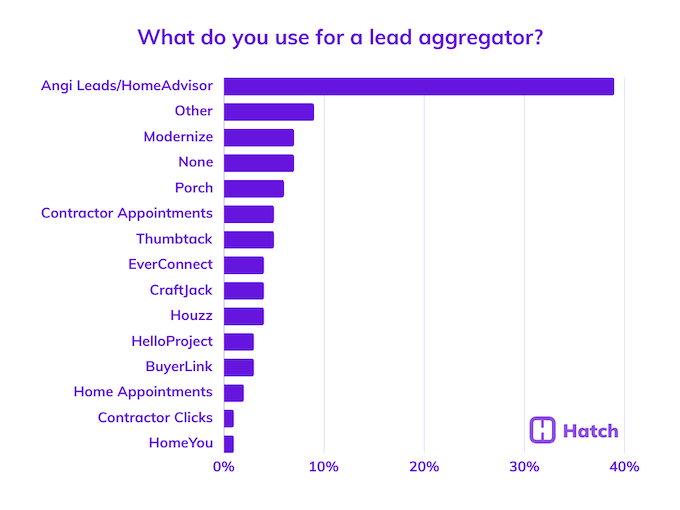
Here are our best resources to help you in generating qualified leads for your home improvement business.
Generating leads is only the first part of the equation. This set of survey questions focused on surfacing the processes, benchmarks, and pain points associated with engaging leads.
By far, the most common person to handle new leads was the call center rep at 60%. Sales reps and marketers handled about 10% of leads, followed by sales managers and office administrators at 7%.
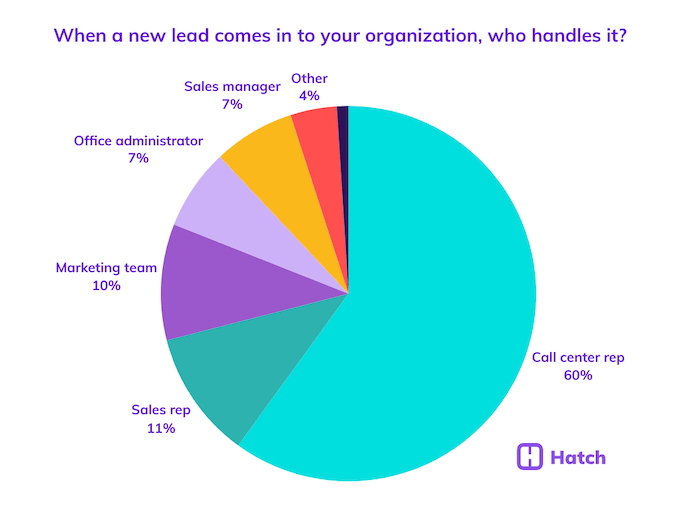
These results align with our recommended best practices for structuring your sales team.
That is, to have a dedicated rep handling new leads who can tag in a sales rep or sales manager when needed. This frees up sales managers to focus on strategy and campaign optimization.
It was encouraging to see that 54% of respondents are reaching out to leads in less than five minutes. This is likely due to the fact that respondents include Hatch users, and Hatch automates your lead outreach so you can maintain this speed to lead.
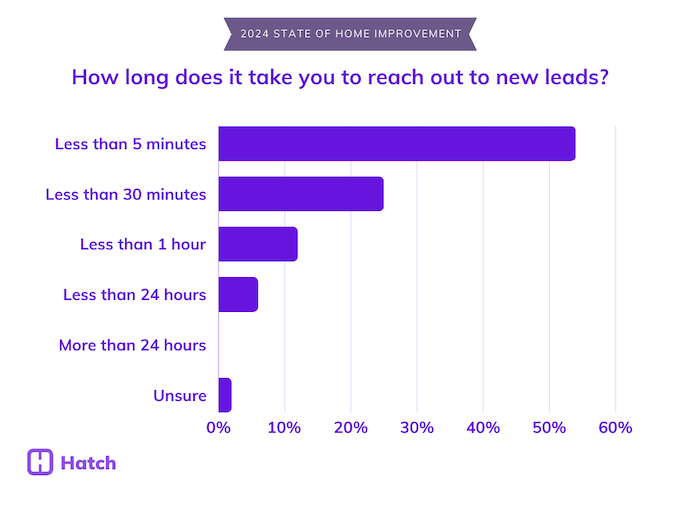
Even still, 43% of respondents are taking longer than five minutes. In the home improvement industry, speed to lead is crucial. After five minutes passes, your chances of connecting with that lead decrease by 900%. We provide resources to help you improve your speed to lead at the end of this section.
98% of call centers reported using the phone to reach out to leads, while 79% reported using text, and 72% email.
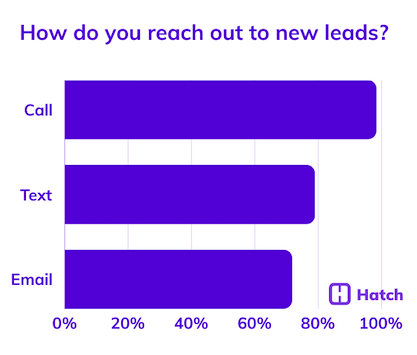
This isn’t surprising, as call centers have traditionally been call centers. But not using an omnichannel strategy—and neglecting text in particular—can hinder response rates and ultimately your bottom line.
This doesn’t mean all of your communication has to happen over text. But it is most effective in getting that initial response, after which you can further the conversation over the contact’s preferred channel. In fact, texting has a 98% open rate vs email at 20% and calling (answer rate) at 18%; and 69% would prefer for an unfamiliar company to contact them over text messaging, rather than over the phone.
Homeowners are harder than ever to reach today. They’re reaching out to several service providers at once, most likely while they’re at work or doing something else at the same time, and they do not want to pick up the phone and talk.
It makes sense then, that the largest percentage of call center respondents (18%) reported a relatively low response rate of 31-40%. But respondents also included Hatch users, and given that Hatch is designed to increase response rates, it’s not surprising that not far behind, at 17% of respondents, was a 61-70% response rate.
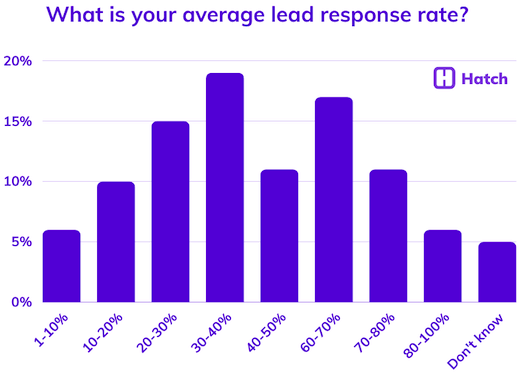
Most of the businesses we talk to report a set rate of 20-30%, and then once they start using Hatch their set rates increase to 60-70% and typically work up to 70-80%.
Since respondents included non Hatch users, new Hatch users, and veteran Hatch users, this might explain why the three most common set rates were 20-30%, 60-70%, and 70-80%.
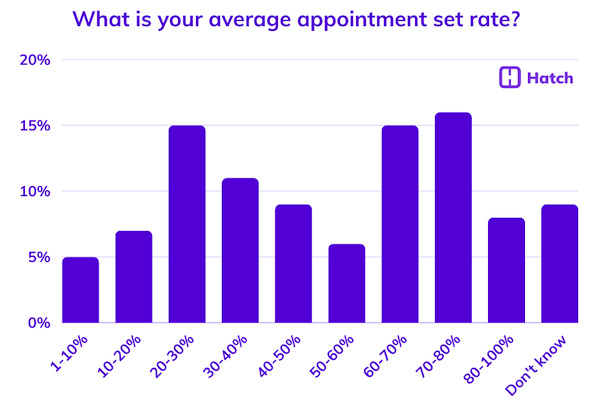
57% of call centers are reaching out more than four times before considering a lead lost. This is great because it can take 8-12 touches to reach a lead.
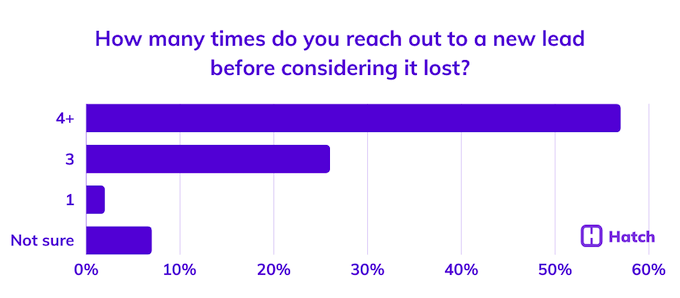
What’s important to note, however, is that those multiple touches should be occurring over the course of several days and several channels. So rather than calling a lead several times on the first day, the best practice is to implement a sequence.
Leads and prospects can fall off the map for reasons other than being not interested, so it’s important to check up on aged leads regularly. This is sometimes referred to as rehash or database mining, and 83% of call centers in our survey reported using this best practice.
Of that 83%, 67% reported using individual communication (call, email, or text), 60% reported using mass email or text, and 19% each reported using direct mail and retargeting through paid ads.
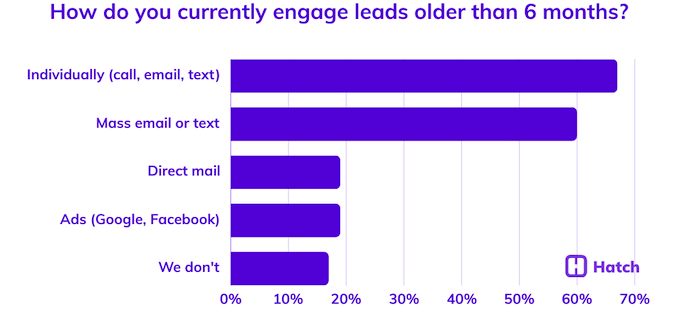
To get higher response rates, you need to reach out immediately (within five minutes), across multiple channels (text, email, and phone), with the right messaging, and follow up until you get a response. Here are some resources to help you out with executing these best practices:
This portion of the survey covered the processes and people involved in converting leads into sales.
The most commonly reported close rate was 20-30%, making up 28% of respondents. This is relatively low, but it’s not surprising since we know that 80% of sales require 5-12 touches, and respondents are only following up once or twice. Furthermore, they are waiting longer than 2 days to follow up on quotes and still using phone more than text.
The fact that there were respondents reporting close rates up to 80% respondents, however, shows that higher close rates are possible. And we’d venture to guess that the respondents with the higher close rates are the ones using Hatch, since Hatch makes it easy to conduct sales follow-up—which is the key to higher close rates. The rest of the questions in this section address this best practice.
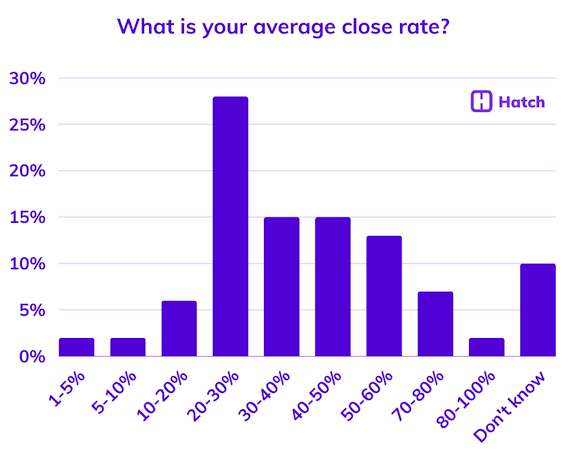
While the call center rep was the most popular role for handling new leads (61%), the sales rep was the most popular role for handling quoted leads (44%). This is typical for call centers, although having a dedicated follow-up rep can help to ensure even fewer opportunities fall through the cracks. 18% of respondents reported having such a rep.
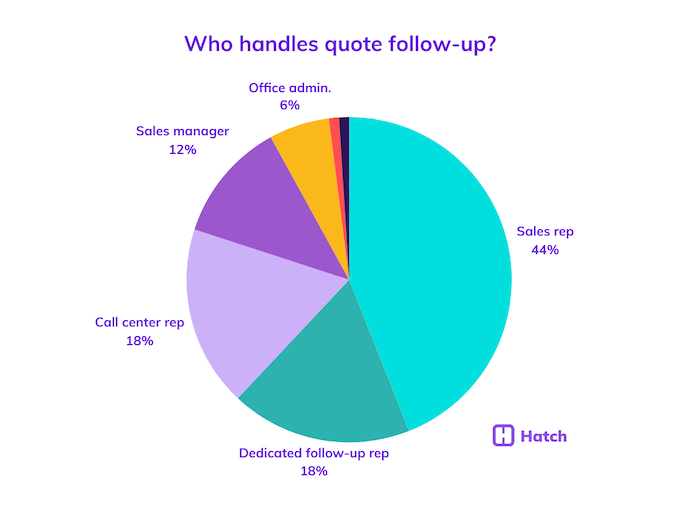
The key to closing more deals is following up within two days of the quote. Your chances of engaging that lead drop below 20%.
75% of respondents in our survey reported following up within two days, which is great to see. 15% are waiting up to six or more days.
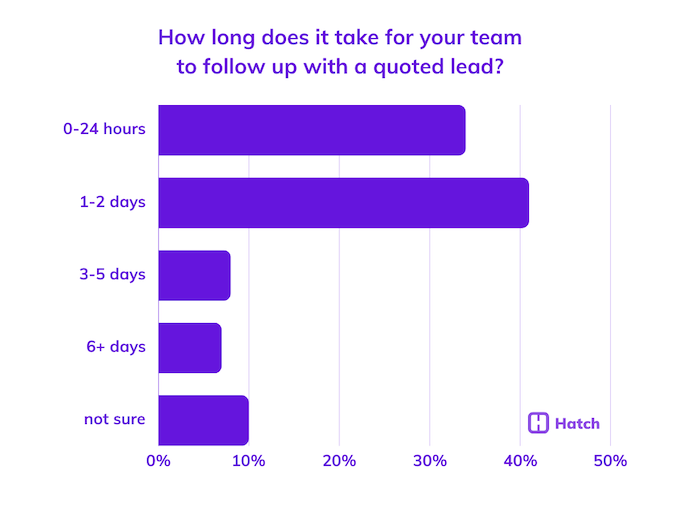
Similar to the above question on reaching out to new leads, the most common method was through phone call (41%), and both email and text were tied at 30%.
As mentioned above, text is most effective in getting the response from new leads, and it’s no different for quoted prospects. That there are still call centers out there not using email or text shows that employing these channels can give you a competitive advantage.
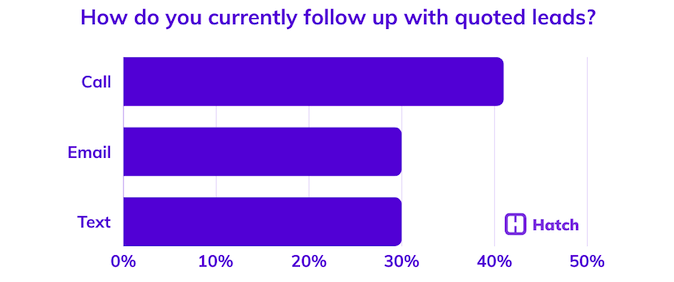
Homeowners are hard to get a hold of today. It takes 8-12 encounters to get a lead to engage (as mentioned above) and 5-12 touches to close. But while 57% respondents reported reaching out to new leads four or more times, only 14% reported reaching back out to quoted leads this many times before marking them as lost. In fact, 63% are only reaching out once or twice.
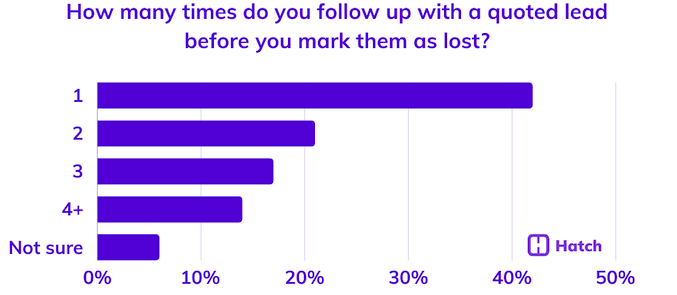
The most popular CRM in our survey was Salesforce (24% of respondents) followed by ServiceTitan (17%)—unsurprising as these are the most popular CRMs in business and home services, respectively.
But while the most popular CRM was Salesforce—an industry-agnostic tool—when you aggregate the results, you see that 56% of respondents are using CRMs specific to home service businesses, versus 28% using general CRMs.
Contractor-specific tools are designed around the daily operations, pain points, goals, unique to contracting businesses and can therefore offer benefits, time savings, and other capabilities you may not find in a general CRM.
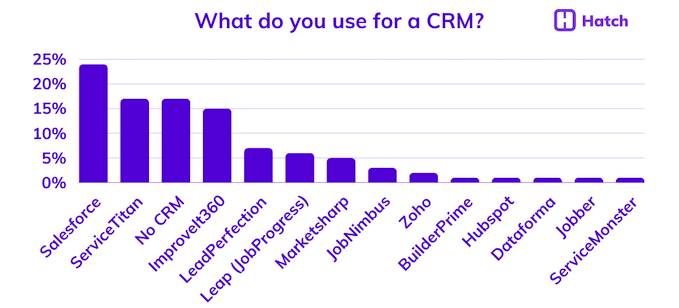
What was surprising was that 17% of respondents reported not using a CRM at all.
A customer-relationship management tool (CRM) is a must for any business today. These systems house all of your contacts—their information, their interactions with your business, and your correspondence with them—all in one place. This enables businesses to engage with each contact in a personalized manner, which is paramount today.
To close more deals, you need to reach out within two days, follow up several times until you get a response, be prepared to handle objections, and use your CRM properly. Here are our resources to help with this:
The final portion of our survey sought to understand where home improvement call centers stand with relation to age-old pain points (such as retention and efficiency) and new trends (such as AI).
Call centers were given six key call center goals and asked to order them by importance (1 being least important). Here are the goals and their average scores:
Keep in mind, however, that “low” scores in this result do not indicate lack of importance—each of these issues are all top priorities among call centers—rather, the low scorers are of lesser importance relative to the other items on the list.
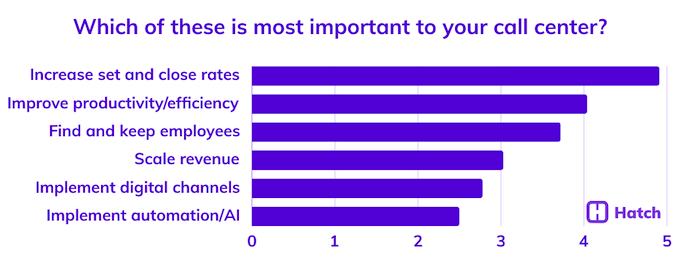
For help with some of the goals mentioned above, here are some resources you can refer to:
The importance of a goal is one thing; how easy it is to achieve it is another. We asked respondents to order the same goals above by level of difficulty. Employee productivity and operational efficiency was rated as the most difficult, followed by finding and keeping employees, and implementing digital channels.
When comparing importance vs difficulty, the issue with the biggest discrepancy was increasing set and close rates. It was rated the most important while also not being a major challenge.
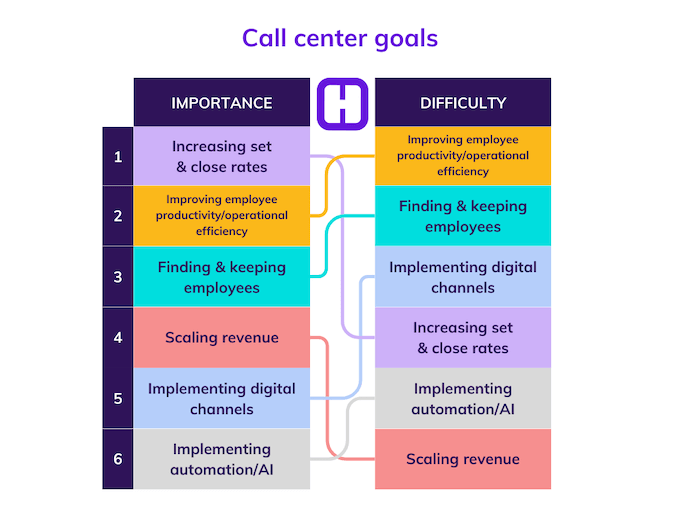
With AI implementation being a clear trending challenge among businesses today, we found it interesting that respondents considered implementing AI/automation as both low in importance and in difficulty. But automation has already been a standard among many call centers, and it was grouped in with AI in this question, so that might be the reason behind this result.
It’s also worth mentioning that automation and AI play an important role in achieving the rest of the goals on the list.
As businesses are still trying to grasp the use cases and advantages of AI, we curated a list of the benefits of AI for home improvement call centers and asked respondents to pick their top three.
Here is that list of benefits, ordered by their popularity:
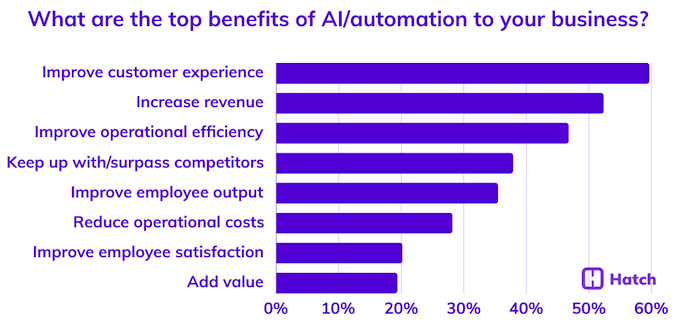
While 29% of respondents are already using AI, 29% do not have plans to implement AI in 2024. 28% do intend to implement AI but only a quarter of those respondents have a clear plan in place to do so. 15% are not ready yet.
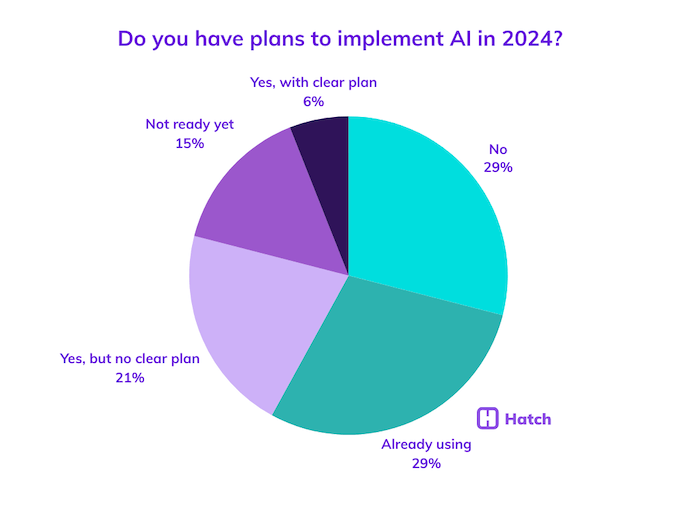
If you're planning to implement AI in your business in 2024, you should consider choosing Hatch AI, which is designed specifically for home improvement businesses.
Hatch Assistant, the Hatch AI offering, is a generative AI tool that provides you with chatbots that converse directly with leads, prospects, and customers based on rules and information you provide.
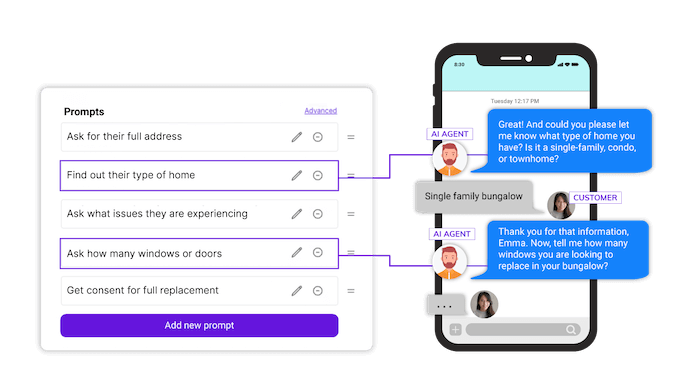
Learn more about how Hatch AI works or try it for yourself!
Depending on where you are in your AI journey, here are some resources to help:
For this report, we surveyed 124 home improvement call centers located in the US, with call centers being defined as having a minimum of eight employees. Respondents included Hatch and non Hatch users. See below for more specifics on verticals, company size, and more.
The largest vertical represented by respondents was Windows & Doors (32%), followed by HVAC, Plumbing, and/or Electrical (20%). Remodeling made up 16% of respondents; Roofing, Siding, and/or Gutters made up 14%; and Solar and Painting were at 4% and 2%, respectively.
The “Other” category, which comprised 12% of respondents, included pest control, dumpsters, generator sales and service, foundation and waterproofing, insulation, and more.
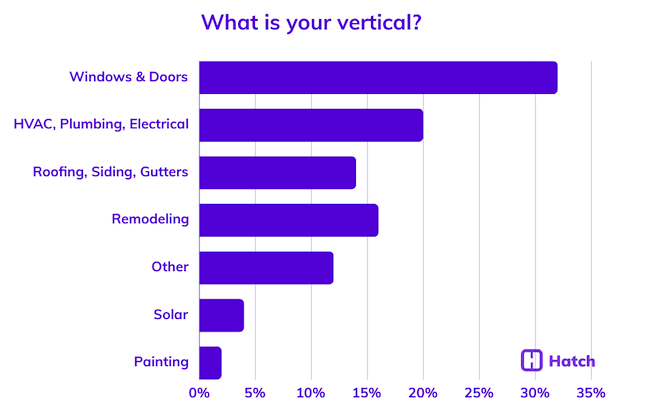
Over half (56%) of respondents had a company size of 51 or more employees. The next largest group was 26-50 employees (19%), followed by 11-25 employees (14%) and 1-10 employees (10%).
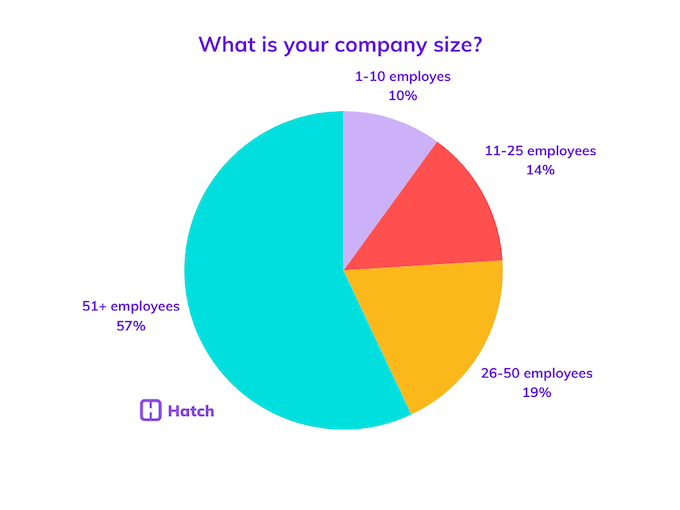
The larger the company, the more likely it is to have a call center, but these results show us that even small businesses can, and should, have call centers. Any establishment in charge of customer communication can be considered a call center and is essential for ensuring growth as well as customer satisfaction.
The distribution of appointments per week aligns with the above results for average company size. Since the majority of respondents had 51+ employees, it makes sense that they book between 20-500 appointments per week.
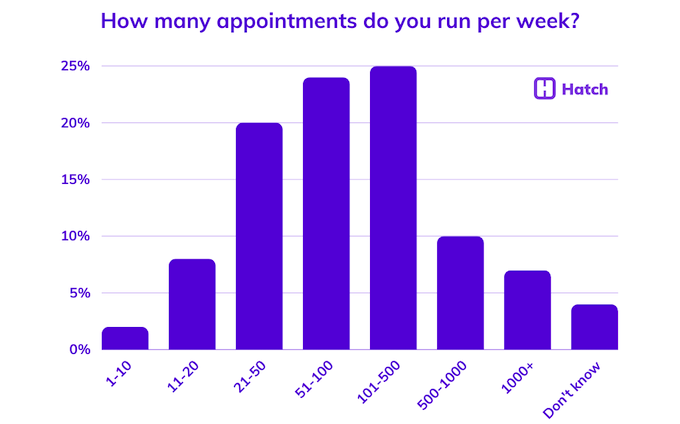
The two most common answers to this question were $15-25K (35% of respondents) and $5-10K (32% of respondents). Keep in mind that over half of respondents had a company size of 51+ employees, so this price range makes sense.
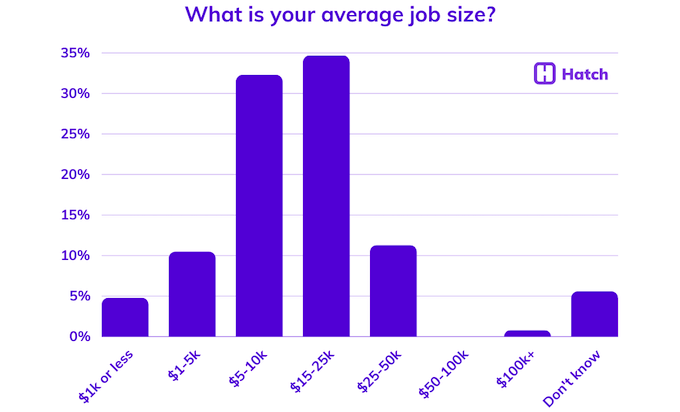
Use these tips, tools, and templates to not only reach out to every lead within 5 minutes, but to get responses too.
Book more appointments and sales with these 10 ways to improve your speed to lead—plus lead response time stats.
Your marketing efforts should go beyond simple lead generation. Learn how to manage inbound leads and discover effective tips to convert them into...
Be the first to know about new sales and marketing insights to grow your messaging strategy with leads and customers.